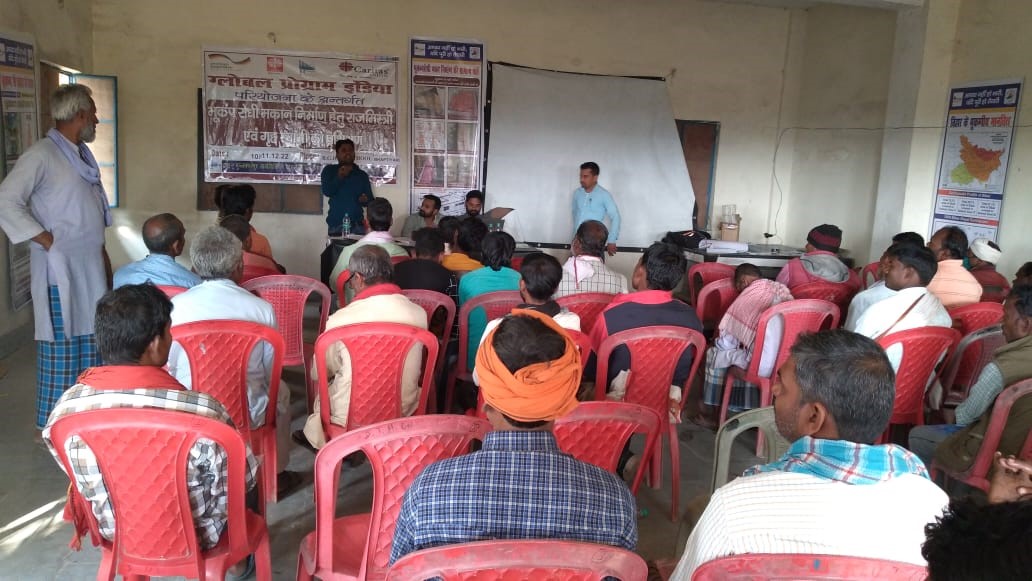In the face of a changing climate and the ever-looming threat of natural disasters, the need for resilient infrastructure cannot be overstated. Bihar, one of the most disaster-prone regions in India, has been setting ambitious goals to ensure the safety and resilience of its infrastructure. As part of Bihar’s Disaster Risk Reduction Road Map, the sixth pillar focuses on resilient critical infrastructure, with a clear objective: “Training of Engineers, Architects, Masons, etc., for safe construction of projects and buildings completed by 2030.” This goal is not merely aspirational; it’s a critical step toward reducing vulnerability and mitigating disaster risks in the region.
In a remarkable alignment with this vision, Caritas India Global Program has been playing a pivotal role in ensuring that this objective becomes a reality. Under the global program, a comprehensive series of Mason training sessions on safe construction techniques have been conducted, effectively contributing to building resilient homes and structures in the state of Bihar. These efforts are in line with the larger program’s goals of reducing the vulnerability of the population to disasters and minimizing the number of victims and extent of damage caused by such events. The essence of this initiative lies in enhancing the disaster management system at the national, state, and local levels, ultimately making Bihar a safer place to live and thrive.
In 2022 and 2023, Caritas India, through its dedicated team and partners, orchestrated two significant training sessions aimed at enhancing the skills and knowledge of masons, engineers, and architects. One key individual who deserves special mention for his role in ensuring the success of these training programs is Mr. Praveen, who went above and beyond to arrange resources and support for the trainees. These training sessions, conducted in Supaul, saw the active participation of 84 individuals, comprising 56 masons and 28 beneficiaries of the Pradhan Mantri Awas Yojana (PMAY).
One of the shining examples of the impact of these training programs is Chit Narayan Ram, a prominent mason from Supaul, Bihar. After completing the training, he became an advocate for safe construction practices. To date, he has successfully constructed 15 houses across two Panchayats, transforming his knowledge into tangible, resilient structures that stand as a testament to his dedication and the effectiveness of the training provided.

The training sessions, conducted by experienced trainers Mr. Alok Kumar and Abhinav Kumar from the Bihar State Disaster Management Authority, were designed with a specific focus on safe construction techniques, particularly those aimed at making houses earthquake-resistant. The participants, including Chit Narayan Ram, gleaned invaluable knowledge and skills during these sessions, which proved to be life-changing.
Chit Narayan Ram, in particular, shared insights into how he and his fellow trainees applied their newfound knowledge to construct disaster-proof and earthquake-resistant buildings. Here are some of the key techniques and practices they adopted:
• Quality Check of Materials: Before purchasing cement, steel rods, and bricks, they diligently checked the quality to ensure superior materials were used.
• Procurement Process: After confirming the quality of cement and steel rods, they recommended the purchase of required materials. Iron (steel rods) was purchased only after thorough foundation work inspection.
• Use of Pure Sand: A commitment to quality construction was evident as they used pure sand in the construction process.
• Proper Placement of Steel Rods: The meticulous approach continued with the maintenance of a specific distance between the ring and the steel rod, ensuring structural integrity.
• Preparing Bricks: To enhance brick quality and durability, they soaked them in water for four hours before use.
These practices, though seemingly small, collectively contributed to the construction of 15 resilient buildings that are now capable of withstanding earthquakes and other potential disasters. The impact of these structures extends far beyond the material realm; they provide safer living spaces for communities in Bihar and stand as a beacon of hope in a region vulnerable to natural calamities.
Chit Narayan Ram’s journey from being a participant in the Mason training program to a builder of resilient homes is a prime example of how knowledge and empowerment can create a ripple effect of resilience. His 15 earthquake-resistant houses are not just physical structures; they represent hope, security, and a brighter future for the communities they serve.
Moreover, these structures stand as signs of resilience in a region where the threat of disasters is a constant reality. They serve as a stark reminder that with the right training and commitment to best practices, communities can withstand even the most formidable challenges that nature may present.


Leave a Reply